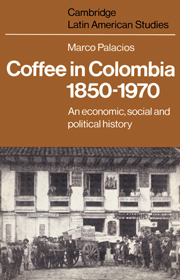Book contents
- Frontmatter
- Contents
- List of tables
- List of figures
- List of maps
- Preface
- Acknowledgements
- 1 The Colombian export economy in the second half of the nineteenth century
- 2 The making of an oligarchy
- 3 Land and society in central Colombia in the second half of the nineteenth century
- 4 The internal structure of the coffee haciendas, 1870–1930
- 5 Living conditions and internal contradictions in the hacienda structure
- 6 Inflation, devaluation, and export taxes, 1870–1904
- 7 Crisis and transition towards the second cycle of expansion, 1903–10
- 8 Private appropriation of public lands in the west
- 9 Sociopolitical elements in antioquen̄o colonization
- 10 Coffee expansion and the strengthening of the Liberal model of development, 1910–50
- 11 The international cycle and coffee policies confronting the peasant, 1930–70
- Appendix 1 Sample of coffee estates in Cundinamarca and Antioquia, 1870–98
- Appendix 2 Piece-rate wages on two coffee haciendas, 1879–1933
- Appendix 3 Concentration of the coffee export trade (percentage controlled by 20 leading companies), 1933–70
- Appendix 4 Foreign exchange rates in Colombia, 1870–1970
- Weights and measures
- Glossary
- Notes
- Biblography
- Index
- CAMBRIDGE LATIN AMERICAN STUDIES
3 - Land and society in central Colombia in the second half of the nineteenth century
Published online by Cambridge University Press: 06 October 2009
- Frontmatter
- Contents
- List of tables
- List of figures
- List of maps
- Preface
- Acknowledgements
- 1 The Colombian export economy in the second half of the nineteenth century
- 2 The making of an oligarchy
- 3 Land and society in central Colombia in the second half of the nineteenth century
- 4 The internal structure of the coffee haciendas, 1870–1930
- 5 Living conditions and internal contradictions in the hacienda structure
- 6 Inflation, devaluation, and export taxes, 1870–1904
- 7 Crisis and transition towards the second cycle of expansion, 1903–10
- 8 Private appropriation of public lands in the west
- 9 Sociopolitical elements in antioquen̄o colonization
- 10 Coffee expansion and the strengthening of the Liberal model of development, 1910–50
- 11 The international cycle and coffee policies confronting the peasant, 1930–70
- Appendix 1 Sample of coffee estates in Cundinamarca and Antioquia, 1870–98
- Appendix 2 Piece-rate wages on two coffee haciendas, 1879–1933
- Appendix 3 Concentration of the coffee export trade (percentage controlled by 20 leading companies), 1933–70
- Appendix 4 Foreign exchange rates in Colombia, 1870–1970
- Weights and measures
- Glossary
- Notes
- Biblography
- Index
- CAMBRIDGE LATIN AMERICAN STUDIES
Summary
The coffee hacienda was the result of the entry of urban merchants into rural society. On a yet more general plane, it was the product of emphasis on agricultural exporting, of the urge and the need to form links with the world market and ‘bring to the country the civilization that is overflowing in Europe’. Investment in coffee did not penetrate the rural world in order to create new types of social or productive relations. By the end of the century, for all its dynamism, commercial capital had only scratched the rude surface of the older social formations. The traditions, habits, and customs of the little worlds of a few square kilometres in which most lived out their lives showed a persistent rigour, despite the expectation that the old patterns would dissolve in contact with the new economy which the coffee entrepreneur wished to impose. In part it was a problem of quantity: coffee investment was heavily concentrated in relatively few areas. Even there, the phenomenon of specialization that occurred with tobacco in Ambalema was not repeated. Within the old haciendas of colonial origin there was a peasant stratum accustomed to the degree of independence that came from producing its own food. The coffee hacienda of Santander, Cundinamarca, Tolima, and Antioquia was founded within an existing social structure, to which it had to adapt itself, while at the same time it introduced new elements of the monetary economy which, simple and weak at first, would produce effects that disturbed the old order. In Cundinamarca, for example, the coffee municipios were old centres of colonial production and commerce.
- Type
- Chapter
- Information
- Coffee in Colombia, 1850–1970An Economic, Social and Political History, pp. 55 - 76Publisher: Cambridge University PressPrint publication year: 1980



